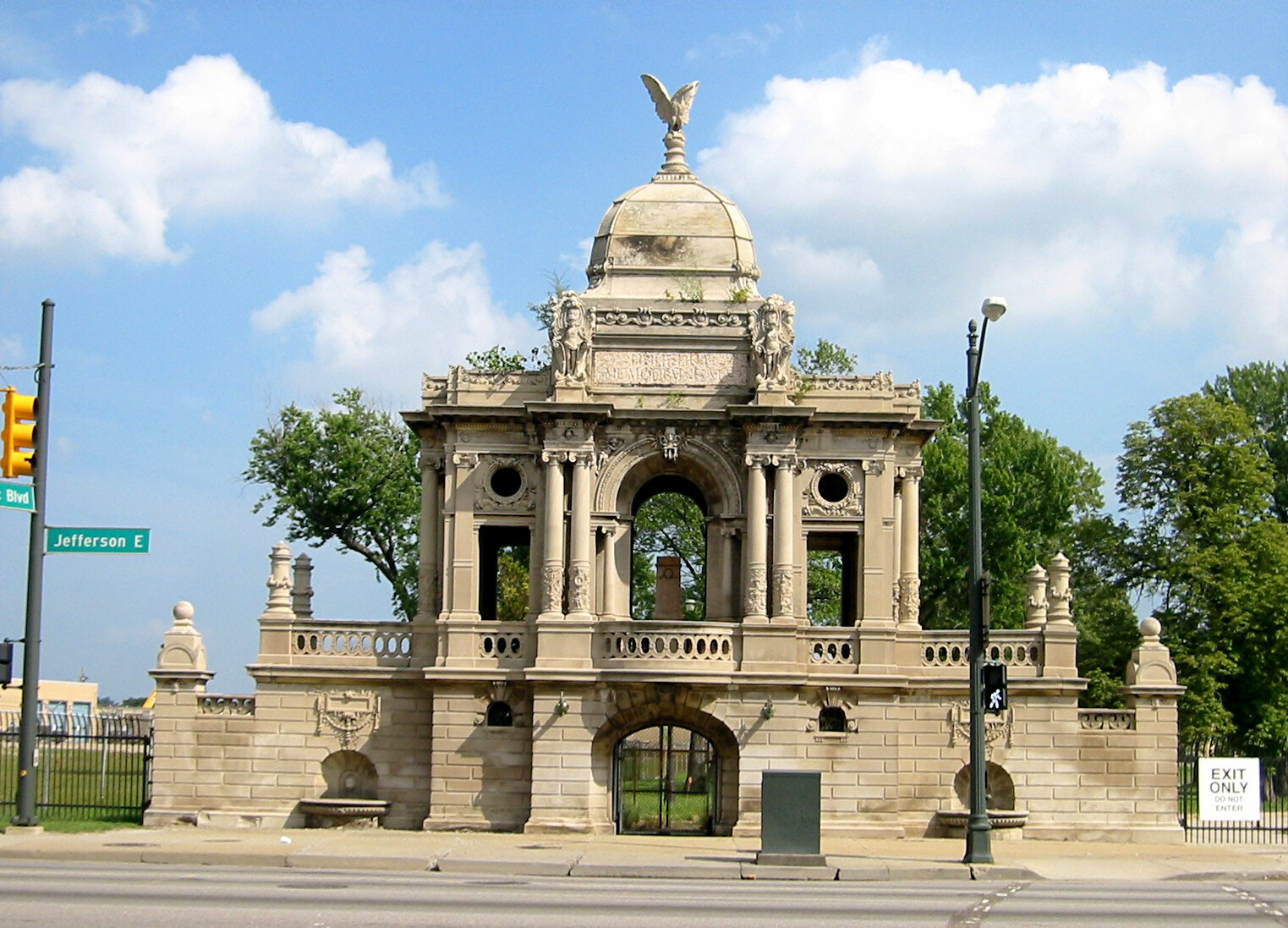
Chauncey Hurlbut Memorial Gate
East Jefferson at the intersection of Cadillac Boulevard and at
the entrance to Waterworks Park
This impressive gate reminds us of the architectural beliefs that guided the use of urban public spaces in the late 19th century. In that era of horse-drawn transportation and smoky bituminous coal, cities were extremely densely-packed and dirty places, so cemeteries, parks and waterworks provided open and clean spaces. The architectural philosophies of that time called for the erection of impressive gates as openings to these public spaces separating the tranquility of a park or cemetery from the congested and dirty city. An excellent example of this in Detroit is the Gothic arch portal that Gordon Lloyd designed for Elmwood Cemetery in 1882 or the entrance to Woodmere Cemetery on West Fort Street. Perhaps the nation's most magnificent illustration of using a monument to distinguish a park from the city is the massive arch in the Grand Army Plaza entrance to Prospect Park on Flatbush Avenue in Brooklyn designed by Sanford White.
I do not know where Chauncy Hurlbut was born or when he came to Detroit. He established a grocery business in the early to mid Nineteenth Century and, I infer, became wealthy. As many prosperous individuals did in that era, he turned to public service. He served as Detroit’s fire commissioner and then served two terms on the Board of Water Commissioners, the first from 1861 to 1863 and the second from 1868 to 1884. The need for pure water expanded greatly in Detroit after the Civil War as the city’s population grew and manufacturing industries located here. While Hurlbut was serving on the water board, they purchased the 56 acre Grand Marais Farm on East Jefferson from owner Robert Toms. This is the property where the Hurlbut Gate and the High Lift Building are located. This land was used for a modern water filtration plant, one that was replaced by the large building you now see on this property. The design also included a large public park, one that opened in 1893. By the time the park opened, the campus of this facility had increased to 110 acres. Originally, this was known as Hurlbut Park but that name was not a popular one so it was called Waterworks Park. At the time of the completion of the High Lift Building, Detroit’s Common Council decided that the name Waterworks Park was pedestrian. They named it Gladwin Park in honor of the British major Henry Gladwin who commanded Fort Detroit when Chief Pontiac laid siege in the summer of 1763. There are some things a city council can legislate but the name of a park is not one of them so the area is still known as Waterworks Park.
This gate was designed by Herman Brede and Gustave Mueller. Brede, who was born in Copenhagen, came to Detroit as an infant and developed an architectural practice. Gustave Mueller, who was born in Germany, migrated to Detroit after architectural training in France and service with the French company that attempted to construct a Panama Canal. Using Bedford limestone, they produced the elaborate three-tiered triumphal Beaux Arts arch that you see today. It is 132 feet in length and more than 50 feet high. Carved garlands, water fonts and roundels decorating the gate reflect the tastes of the Victorian Age. It also reminds us that patriotism is not just a post 9-11 phenomenon since the American eagle with its outstretched wings soars about this Brede-Mueller masterpiece. I do not know of any other structures that were designed by Brede and Mueller.
Some restoration work was accomplished in the 1990s, but more was needed. Much restoration was completed in 2008. The stairways are closed. The original design included two substantial half-shells along East Jefferson that were to be used as wter troughs for houses. Water no longer flows to these. The statue of Chauncy Hurlbut that once stood inside the attractive dome is still missing. The original architects designed an ornamental iron gate for vehicle entry, but this is no long evident.
It is possible that Hurlbut’s own funds paid for this impressive gate. He died in September, 1885 and left $50,000 to the Detroit Water Board for the purposes of improving the grounds of Waterworks Park. His wife died the next year and, after that, the remainder of his very substantial estate apparently went to the Detroit Water Board. The renovation work was, apparently, also paid for by Chauncy Hurlburt. The Detroit Water and Sewage Department administers an Hurlburt Trust funded by his 1885 donation.
.
Architects: Herman A. Brede and Gustave Mueller
Date of Completion: 1894
Architectural Style: Beaux Arts
Date of most recent renovation: 2008
State Historical Register: Listed July 26, 1974
National Register of Historical Sites: Listed March 27, 1975
Photo: Andrew Chandler; July, 2004
Description updated: October, 2011
Return to Public Art and Sculpture